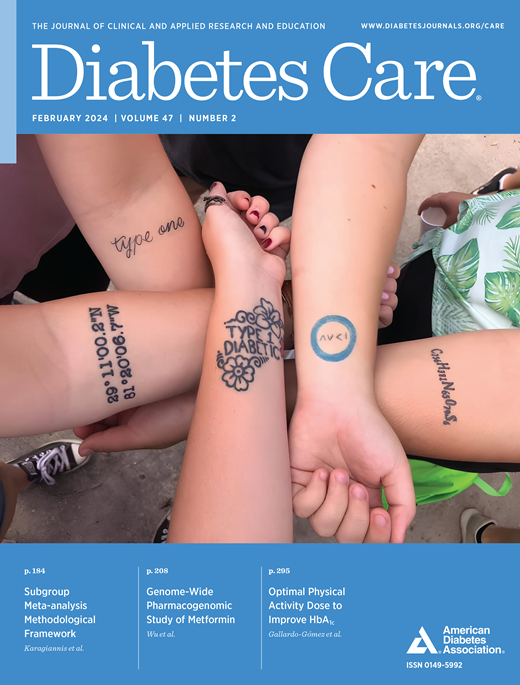Association Between Diabetes and Anemia: Evidence From NHANES and the UK Biobank
IF 16.6
1区 医学
Q1 ENDOCRINOLOGY & METABOLISM
引用次数: 0
Abstract
OBJECTIVE To explore the association between diabetes and anemia. RESEARCH DESIGN AND METHODS We included 9,026 and 389,616 participants from the U.S. National Health and Nutrition Examination Surveys and the UK Biobank study (UKB), respectively. Multivariable logistic regression was used to examine the cross-sectional association of diabetes with anemia, as defined by hemoglobin measurement. For the UKB follow-up, multivariable Cox proportional hazards regression was performed to estimate hazard ratios (HRs) and 95% CIs of incident anemia, as defined by hemoglobin levels or diagnosis records, in relation to diabetes. We further assessed the impact of inflammation, renal dysfunction, and medication use on this association in both populations. RESULTS Among White people aged 40–69 years in the U.S. and U.K., the adjusted odds of study participants with diagnosed diabetes also having anemia was two to four times higher than in those with normal glycemia. Over a median follow-up of 13.6 years in the UKB, 42,354 people developed anemia. The adjusted HRs for incident anemia comparing diagnosed diabetes with normal glycemia were 3.05 (95% CI 2.90–3.21) for iron deficiency anemia, 3.02 (95% CI 2.51–3.63) for anemia of chronic disease, and 4.88 (95% CI 4.23–5.63) for vitamin B12 deficiency anemia. Further adjustment for inflammation, renal dysfunction, and medication use partially attenuated these associations, but they remained strong and significant. CONCLUSIONS Diabetes was associated with several major types of anemia. Further studies are warranted to identify the mechanisms.糖尿病和贫血之间的关系:来自NHANES和英国生物银行的证据
目的探讨糖尿病与贫血的关系。研究设计和方法我们分别纳入来自美国国家健康与营养调查和英国生物银行研究(UKB)的9026和389616名参与者。多变量logistic回归用于检验糖尿病与贫血的横断面关联,由血红蛋白测量定义。对于UKB随访,采用多变量Cox比例风险回归来估计由血红蛋白水平或诊断记录定义的与糖尿病相关的偶发贫血的风险比(hr)和95% ci。我们进一步评估了两种人群中炎症、肾功能不全和药物使用对这种关联的影响。结果:在美国和英国40-69岁的白人中,诊断为糖尿病的研究参与者同时患有贫血的调整后几率比血糖正常的研究参与者高2 - 4倍。在英国平均13.6年的随访中,42354人出现贫血。将诊断为糖尿病的贫血与血糖正常的贫血相比,缺铁性贫血的校正hr为3.05 (95% CI 2.90-3.21),慢性病性贫血的校正hr为3.02 (95% CI 2.51-3.63),维生素B12缺乏性贫血的校正hr为4.88 (95% CI 4.23-5.63)。对炎症、肾功能不全和药物使用的进一步调整部分减弱了这些关联,但它们仍然很强且显著。结论:糖尿病与几种主要类型的贫血相关。有必要进一步研究以确定其机制。
本文章由计算机程序翻译,如有差异,请以英文原文为准。
求助全文
约1分钟内获得全文
求助全文
来源期刊

Diabetes Care
医学-内分泌学与代谢
CiteScore
27.80
自引率
4.90%
发文量
449
审稿时长
1 months
期刊介绍:
The journal's overarching mission can be captured by the simple word "Care," reflecting its commitment to enhancing patient well-being. Diabetes Care aims to support better patient care by addressing the comprehensive needs of healthcare professionals dedicated to managing diabetes.
Diabetes Care serves as a valuable resource for healthcare practitioners, aiming to advance knowledge, foster research, and improve diabetes management. The journal publishes original research across various categories, including Clinical Care, Education, Nutrition, Psychosocial Research, Epidemiology, Health Services Research, Emerging Treatments and Technologies, Pathophysiology, Complications, and Cardiovascular and Metabolic Risk. Additionally, Diabetes Care features ADA statements, consensus reports, review articles, letters to the editor, and health/medical news, appealing to a diverse audience of physicians, researchers, psychologists, educators, and other healthcare professionals.
 求助内容:
求助内容: 应助结果提醒方式:
应助结果提醒方式:


